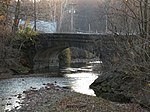The ScareHouse
ScareHouse is a haunted attraction now located within The Galleria at Pittsburgh Mills in Pittsburgh, Pennsylvania. In 2013 CBS News called ScareHouse "One of America's Scariest Haunted Houses". ScareHouse received additional recognition from Guillermo del Toro who stated "It really is beautiful. With the sound design and the atmospherics, it is beautiful. I could live here!" and Michael Dougherty who stated: "I left so happy and inspired. You guys nailed it!" In 2010 the ScareHouse was rated as one of "The 10 Wickedest Haunted Houses In America" by Forbes Magazine, and in 2012 was rated #5 in the US in Top Haunt Magazine's Top 13 Haunts. The ScareHouse offers heavily themed attractions or "haunts" which are significantly revised on a yearly basis along with an interactive, immersive, 18 and over attraction titled "The Basement".
Excerpt from the Wikipedia article The ScareHouse (License: CC BY-SA 3.0, Authors).The ScareHouse
Butler Street,
Geographical coordinates (GPS) Address Website External links Nearby Places Show on map
Geographical coordinates (GPS)
| Latitude | Longitude |
|---|---|
| N 40.499211 ° | E -79.944018 ° |
Address
Scarehouse
Butler Street
15223
Pennsylvania, United States
Open on Google Maps







